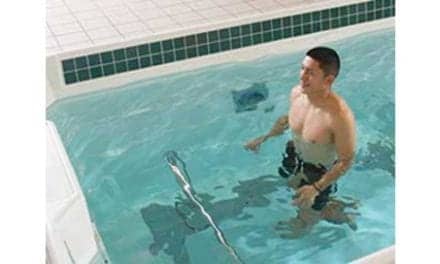
A patient with a primary diagnosis of chronic obstructive pulmonary disease (COPD) exacerbation and pneumonia works on cardiorespiratory endurance with her physical therapist, Ryan D. Morton, PT, DPT, using a recumbent cross trainer
By Ryan D. Morton, PT, DPT
The rise in obesity rates has been an undisputed fact in the medical community. As of 2014, 36.5% of the US population is classified as obese, and the occurrence has significantly increased in the past 20 years.1 The healthcare system has been overburdened by these medical expenses, and the costs have been steadily increasing. On average, an obese individual’s medical expenses were $1,500 more per year as compared to a normal-weight individual.2 Individuals with obesity have a significantly higher risk for a long list of health conditions, including stroke and heart disease,3 which are the leading causes of morbidity across all populations, not just those who are obese.3 Given these rising costs, this places more responsibility on each consumer across the country to take ownership in his or her own health. This correlates with the recent changes in insurance coverages and reimbursements to promote preventative care as opposed to the unsuccessful tertiary model. The field of physical therapy relies on this ownership to allow for long-term lifestyle changes to prevent hospital readmission and further complications.
When a patient is admitted to an inpatient rehabilitation hospital following acute hospitalization, this is sometimes one of the earliest attempts to help change a patient’s behaviors and physical capabilities prior to returning home and, ultimately, back to their normal lives. Acute rehabilitation settings require each patient to receive at least 3 hours of skilled therapy per day over an average of 2 weeks. This helps patients achieve their goals and return to the community with more education about their condition and the tools needed to be successful long-term. Physical therapy gyms in rehabilitation hospitals are full of innovative equipment that requires experience, knowledge, and creativity in order to prescribe properly and achieve patient goals.
[sidebar float=”right” width=”250″]Product Resources
The following companies offer fitness products for physical therapy practices as well as for use in home-based programs:
Biodex
www.biodex.com
Brookdale Medical
www.brookdalemedical.com
BTE
www.btetech.com
Clarke Health Care Products
www.clarkehealthcare.com
Dynatronics
www.dynatronics.com
Exertools
www.exertools.com
Fitter International Inc
www.fitter1.com
Hoggan Scientific LLC
www.hogganhealth.net
Magister Corporation
www.magistercorp.com
Mettler Electronics
www.mettlerelectronics.com
NZ Manufacturing
www.nzcordz.com
OPTP
www.optp.com
Performance Health
www.performancehealth.com
Spirit Medical Systems Group
www.spiritmedicalsystems.com
SPRI Products
www.spri.com
Stretchwell
www.stretchwell.com
The Hygenic Corporation
www.hygeniccorp.com
Tri W-G Inc
www.triwg.com[/sidebar]
In the acute rehabilitation setting, therapists see obese individuals with varying levels of mobility, ranging from those who need help rolling in bed to those who want to walk to the mailbox without running out of breath. It is not uncommon to see patients in the acute rehabilitation setting greater than 400 pounds, which requires specialized equipment designed to handle increased weight limits. This type of equipment is larger, more expensive, and requires more skill to function safely.
An obese individual who cannot stand up is sometimes the most challenging for a physical therapist, as their goals are typically to walk and regain independence when returning home. The challenges are due to increased physical exertion on the part of physical therapists, increased risk of falls and, at times, the assistance of two or more additional therapists needed to achieve desired movements. If the goal is to improve the patient’s ability to stand or walk, the use of specialized equipment, such as a standing frame, tilt table, or gait training harness, is necessary to achieve the patient’s goals in a safe manner for both patient and therapist.
Lower extremity exercises with bands and weights are effective at increasing strength, but to make larger improvements, functional tasks like standing and walking will boost outcomes with increasing weight bearing through the legs.4 Tilt tables such as those available from Tri W-G, Valley City, ND, are usually intended for improving tolerance to upright positioning due to orthostatic hypotension but can be an effective method for promoting safe weight bearing in the initial stages. The tilt table is less commonly used as an effective leg press machine for lower extremity strengthening, and is much easier to get onto than the typical leg press machines found in the gym, especially if the patient requires a mechanical lift or assistance with transfers.
The intensity and amount of weight bearing through the legs can be calculated for partial weight bearing individuals using the table angle.5 Most standard tables have a weight limit of 300 to 350 pounds. Bariatric tables, though less common, are available as well. Recent evidence related to early mobilization in ICU have led to the increased use of Vital Go Lift Beds, Vital Go Systems, Ft Lauderdale, Fla, which are standard hospital beds that can tilt vertically to allow a patient to stand up completely and eliminate the need to transfer the patient. There is a standard option as well as a bariatric version, which has a weight limit of up to 1,000 pounds. When obese patients need assistance standing, the use of mechanical options are the safest to prevent injury for both therapist and patient.
Standing frames such as the Metron Elite from Patterson Medical, Warrenville, Ill, are often used to improve patients’ standing tolerance with a more natural posture, compared to the tilt table. This type of equipment uses a harness around the patient’s hips and lifts them from a sitting position to standing with joint blocking to promote knee and hip extension. This can be more challenging than the tilt table because the patient’s trunk and upper body are not supported, requiring increased use of postural muscles along with lower extremity due to supported standing position. Most standard versions have a weight capacity of 300 pounds, while bariatric versions can manage up to 600 pounds.
The last and most common device to assist with standing or walking is the functional training harnesses from Biodex, Shirley, NY. These harnesses will assist the patient in a standing position and allow for hands-on facilitation from the therapist for improving standing posture or gait sequence. The harnesses initially can appear intimidating to both patients and therapists, but the varying manufacturers of harnesses can vary greatly, allowing different usability to a variety of body shapes and functional levels.
If a patient already demonstrates the ability to stand and walk on their own, but is limited in duration or strength, the tools are nearly endless for a physical therapist when determining a treatment plan. For obese patients, there is a need for cardiovascular exercise equipment which will extend long beyond when the patient has discharged home in order to achieve long-term goals. Cardiovascular exercise equipment such as treadmills, recumbent bikes, and total body conditioning machines will be most effective at elevating a patient’s heart rate and maintaining aerobic threshold to burn calories.
The American Heart Association recommends at least 30 minutes of moderate-intensity aerobic activity at least 5 days a week to maintain cardiovascular health.6 Equipment like the recumbent bike SportsArt C535R, SportsArt Fitness, Mukilteo, Wash, and other total body conditioning machines like the NuStep T4r, NuStep, Ann Arbor, Mich, can provide an effective cardiovascular resistance workout with decreased stress on knees and hips commonly seen during weight bearing exercises like walking or running. Recumbent bikes with back support will be more comfortable on hips, buttocks, and back compared to those with typical bike seats and no trunk support. Recumbent bikes also allow for increased core exertion when the angle of rotation is more vertical than horizontal. The NuStep is a low-impact total body conditioning machine that allows for both arm and leg work with recumbent bike positioning. All of these equipment options allow for increased resistance to vary the workload. The ability to change resistance levels makes it very useful for orthopedic patients, such as knee or hip replacements, to improve lower extremity range of motion and muscle activation.
As the patient’s functional capacity improves, the exercise prescription begins to be geared toward giving the patient the necessary tools to continue their exercise program when they transition home. For this reason, the exercises utilize household items and less expensive equipment. Resistance bands and ankle weights are commonly given to progress therapeutic exercises, and the variety of colors and weights allows for progression from single-joint, open-chain to multi-joint, closed-chain movements.
Patients routinely are given independent exercise programs by physical therapists in rehabilitation hospitals, home health and outpatient clinics to safely progress their treatment plan independently. The goal of the physical therapist is to empower patients and give them the tools and motivation to want to meet their goals. Patients who take ownership of their own health will be more successful and hopefully will decrease readmission rates. PTP
Ryan D. Morton, PT, DPT, is a physical therapist at HealthSouth Rehabilitation Hospital of Newnan, in Newnan, Georgia. Ryan earned his bachelor’s degree in exercise and health science from Kennesaw State University and a Doctorate of Physical Therapy at Georgia State University. For more information, contact [email protected].
References
1. Ogden CL, Carroll MD, Fryar CD, Flegal KM. Prevalence of obesity among adults and youth: United States, 2011–2014. NCHS data brief, no 219. Hyattsville, MD: National Center for Health Statistics. 2015.
2. Finkelstein EA, Trogdon JG, Cohen JW, Dietz W. Annual medical spending attributable to obesity; payer- and service- specific estimates. Health Affairs. 2009;28(5):W822-W831. doi: 10.1377/hlthaff.28.5.w822 originally published online July 27, 2009
3. NHLBI Obesity Education Initiative Expert Panel on the Identification, Evaluation, and Treatment of Obesity in Adults (US). Clinical Guidelines on the Identification, Evaluation, and Treatment of Overweight and Obesity in Adults: The Evidence Report. Bethesda (MD): National Heart, Lung, and Blood Institute; 1998 Sep. Available at: https://www.ncbi.nlm.nih.gov/books/NBK2003/
4. Seo H-S, Lee J-H, Park Y-H. Effects of a task-specific exercise program on balance, mobility, and muscle strength in the elderly. J Phys Ther Sci. 2014;26(11):1693-1695. doi:10.1589/jpts.26.1693.
5. Sheldon MR. Comparison of two methods for calculating percent body weight on a tilt table. J Orthop Sports Phys Ther. 1994;19(1):18-21.
6. American Heart Association. American Heart Association Recommendations for Physical Activity in Adults. Available at: http://www.heart.org/HEARTORG/HealthyLiving/PhysicalActivity/FitnessBasics/American-Heart-Association-Recommendations-for-Physical-Activity-in-Adults_UCM_307976_Article.jsp#.WFGb-_krLIU. Published February 2014. Accessed December 14, 2016.





